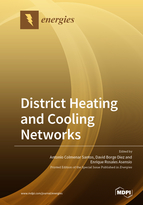District Heating and Cooling Networks
A special issue of Energies (ISSN 1996-1073). This special issue belongs to the section "J: Thermal Management".
Deadline for manuscript submissions: closed (15 January 2020) | Viewed by 53512
Special Issue Editors
Interests: energy efficiency; energy economics; renewable energy; energy simulation; energy optimization
Special Issues, Collections and Topics in MDPI journals
Interests: energy efficiency; energy economics; renewable energy; energy simulation; energy optimization
Special Issues, Collections and Topics in MDPI journals
Interests: environment management systems; water desalination; waste-heat-recovery technology; electrical engineering
Special Issues, Collections and Topics in MDPI journals
Special Issue Information
Dear Colleagues,
Yearly, conventional thermal generating plants reject a large amount of energy. If this rejected heat were to be used through district heating networks, given a previous energy valorisation, there would be a noticeable decrease in imported fossil fuels for heating. As a consequence, benefits in the form of an increase in energy efficiency, an improvement in energy security, and a minimisation of emitted greenhouse gases would occur. Given that it is not expected for heat demand to decrease significantly in the medium term, district heating networks show the greatest potential for the development of cogeneration.
Due to its cost competitiveness, its flexibility in terms of its ability to use renewable energy resources (such as geothermal or solar thermal) and fossil fuels (more specifically the residual heat from combustion), and the fact that, in some cases, losses to a country/region’s energy balance can be easily integrated into district heating networks (which would not be the case in a "fully electric" future), if appropriate measures were proposed, district heating (and cooling) networks and cogeneration could become a key element for a future with greater energy security, while being more sustainable.
This Special Issue, therefore, seeks to propose an energy strategy for a number of cities/regions/countries, by proposing appropriate measures supported by detailed case studies.
Prof. Dr. Antonio Colmenar Santos
Prof. Dr. David Borge Diez
Dr. Enrique Rosales Asensio
Guest Editors
Manuscript Submission Information
Manuscripts should be submitted online at www.mdpi.com by registering and logging in to this website. Once you are registered, click here to go to the submission form. Manuscripts can be submitted until the deadline. All submissions that pass pre-check are peer-reviewed. Accepted papers will be published continuously in the journal (as soon as accepted) and will be listed together on the special issue website. Research articles, review articles as well as short communications are invited. For planned papers, a title and short abstract (about 100 words) can be sent to the Editorial Office for announcement on this website.
Submitted manuscripts should not have been published previously, nor be under consideration for publication elsewhere (except conference proceedings papers). All manuscripts are thoroughly refereed through a single-blind peer-review process. A guide for authors and other relevant information for submission of manuscripts is available on the Instructions for Authors page. Energies is an international peer-reviewed open access semimonthly journal published by MDPI.
Please visit the Instructions for Authors page before submitting a manuscript. The Article Processing Charge (APC) for publication in this open access journal is 2600 CHF (Swiss Francs). Submitted papers should be well formatted and use good English. Authors may use MDPI's English editing service prior to publication or during author revisions.
Keywords
- energy potential
- cogeneration
- district heating networks
- conversion of thermal power plants
- low-temperature district heating and cooling networks
- institutional and financial barriers







